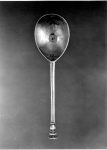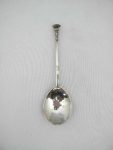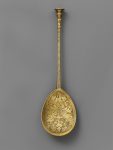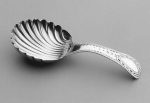Seal Top Spoons are the most commonly found spoons from the 16th and 17th Centuries. They vary in length and design but the tops are always flat with a disc at the end in the form of a seal.
An unascribed mid-17th century silver seal top spoon from the Ellis Collection marked ‘R’ thrice on the stem and once in the bowl With a large bowl, the gilt finial dot-pricked ‘IH 1680 WF’, length 19.9cm, weight 65gms. FOOTNOTES This spoon is described in the Ellis catalogue as ‘Possibly Rochester’, and directs the reader to the original Jackon’s where the illustrated marks are taken from the current lot. However, in Pickford’s edition the mark has been moved to the unascribed section, citing lack of supporting evidence for the demotion. Provenance: Sotheby & co, 13th November 1935, ex lot 112 from “A Remarkable collection of 16th and 17th Century Provincial silver spoons, incorporating the entire collection left by The Late H D Ellis, Esq”
Sold for £ 1,000 inc. premium at Bonhams in 2017
Seal-top spoon; silver-gilt; hexagonal stem, top plain; the bowl concave and pear-shaped with the London leopard head mark inside; on the back of the stem a date-letter and maker’s mark unidentified; the back of the bowl has the Rooke family crest engraved. Possibly by Daniel Cary
Reference: © The Trustees of the British Museum
A SET OF TEN ELIZABETH I SILVER SEAL-TOP SPOONS LONDON, 1567, MAKER’S MARK CC LINKED Each with gilt baluster seal prick engraved with phoenix head erased, each marked in bowl with leopard head and on reverse of handles with maker’s mark, lion passant and date letter, one spoon engraved with a scratch weight ’17-5′, in later fitted satin and felt lined wood box 6 3/8 in. (16.2 cm.) long; 16 oz. 2 dwt. (501 gr.) The phoenix head appears as one of the charges in the arms of the Worshipful Company of Painter-Stainers.
Sold for USD 68,750 at Christies in 2018
James I Sterling Silver Seal Top Spoon Maker’s mark crescent enclosing a mullet (Jackson p. 102, line 12), London, 1605 With a fig-form bowl and parcel-gilt acanthus leaf terminal. Length 6 1/2 inches (16.5 cm.), approximately 1 ounce. While the silversmith using this mark is unknown, he appears to be have been a skilled maker of spoons which appear at auction from time to time.
Sold for $1,250 (includes buyer’s premium) at Doyle New York in 2017
Seal top sterling silver spoon with foliate baluster seal, John Quycke of Barnstaple, c. 1590
Sold for $1,300 at Gary Germer & Associates in 2018
Seal-top spoon English (London) 1610–11 Marked by two clubs in saltire
The spoon has a fig-shaped bowl and a tapering hexagonal stem. The baluster support is surmounted by an oval seal. The bowl and stem of the spoon are forged from a single piece. The seal and chased baluster finial are cast and applied. Traces of gilding remain on the finial. Inscription Engraved on top of seal, T*B Markings In bowl, leopard’s head crowned; on back of stem near bowl, maker’s mark two clubs in saltire in a heart-shaped shield (Jackson, 1921, p. 112; rev. ed. 1989, p. 108); lion passant; date letter N
Reference: Museum of Fine Arts Boston
Unascribed, Gloucester SEAL-TOP SPOON the nimbus prick-engraved I.G. over 1629(?) over M.N. maker’s mark an escallop, stamped once to bowl and thrice to stem, circa 1620 silver. silver-gilt length: 17.1cm., 6 3/4 in.; weight: 36.5gr., 1oz. 3dwt. active circa 1620 – 1640
Sold for 1,375 GBP at Sothebys in 2018
Gilded silver seal top spoon ca. 1620 (made). Pricked on the seal top: ‘ A B 1623’
Reference: © Victoria and Albert Museum








